Organic mulch covers the ground, acting like a tidy, beneficial blanket in your veggie garden — call it the Silent Gardener. Common types include compost, pine needles, fine bark, and wheat straw, among others (see list below). Mulch does many things:
Mulch Functionality
Mulch Gets Plants Through Weather Extremes
During dry spells, mulch can save plants. It acts as an insulator, keeping the soil cool and moist in summer. Vegetables that have their roots in cool soil will be more vigorous and less stressed by heat. In winter, mulch can keep the soil from freezing, an advantage for those who have root crops in the ground. The exception to this is in cold climates, where gardeners either avoid mulching so that the ground can soak up all of the summer sun's rays, or mulch with black landscape fabric or plastic to trap heat.
Mulch Keeps Soil Moist Longer
Water evaporates much more slowly when the soil around the plant is covered with mulch. That means more water for the plant — and less watering for you.
Mulch Keeps Down Weeds
Organic mulch keeps the soil beneath it shaded, loose, and moist. If weed seeds manage to germinate in the dark and rise above the mulch, they are easily uprooted by pulling. But beware that you don't use mulch (or natural fertilizer like chicken litter) that can introduce seeds into the garden.
Mulch Keeps Plants Clean
A mulch blanket under your plants keeps soil from splashing onto the leaves, which in turn helps prevent disease (especially on tomatoes). Lettuce, spinach, and other greens will be a lot easier to wash, too.
Mulch Becomes Valuable Humus
As organic mulches gradually decay, they increase organic matter and, eventually, humus in the soil. Humus is the holy grail of organic matter, as it is the point at which such materials can no longer decay. Instead, they act like a sponge to hold moisture and nutrients. This is the ideal growing environment for most plant roots.
How to Use Organic Mulch
It is important to pick the right mulch and lay it down loosely enough to let water pass through. Blanket the garden with 2 inches of denser mulches like compost or finely ground bark, or 3 inches of lighter, airy ones like pine needles or straw. Consider these types of organic mulch:
Wheat straw is sold by the bale, and it provides a light, fluffy mulch around vegetable plants. Relatively quick to break down, it can be turned into the soil each season and replenished, adding organic matter to the soil without influencing soil pH. But don't confuse wheat straw with hay, which has seeds!
Pine needles (pine straw) are sold by the bale. It's also plentiful for collecting in areas with pine trees. Because the needles knit together and stay put, they're good for slight slopes. They add acidity to the soil, so they are an excellent choice for blueberries (which prefer more acidic soil) and for gardens with neutral to alkaline soil. Otherwise, monitor the pH of the soil with periodic soil tests, and add lime if necessary. Pine needles last a relatively long time, and usually only need to be replenished annually.
Pine bark is a byproduct of milling trees for lumber. For vegetable gardens, choose soil conditioner, which is a very finely ground bark that can also be used as mulch. The finer particles of soil conditioner will turn to compost more quickly and benefit your soil.
Compost that you make at home from garden debris and kitchen trimmings is excellent mulch, as it is higher in nutrients than most other types. Bagged products such as mushroom compost and composted manure give you an instant source until you can create a compost pile. They also contain a few nutrients.
Newspaper may seem like unlikely mulch, but when carefully placed so that sheets overlap and cover the ground 3 sheets thick, newspaper forms a remarkably effective weed barrier. In gardens where weeds matured the previous season and dropped seeds to germinate in the season to come, newspaper mulch can save a lot of time and effort. Be sure to cover it with another layer, such as wheat straw or pine needles, to prevent breezes from blowing the paper sheets around the garden. Sprinkle the paper with water as you work to "prime" it and help keep it from blowing away while you work. By the time you're ready to replant the garden for the next season, the newspaper will have decomposed enough that it can be turned into the soil like any other organic mulch. (Note: Don't use news magazines or glossy inserts, which may contain metal-based inks.)







 Herbs
Herbs
 Vegetables
Vegetables
 Fruit
Fruit
 Flowers
Flowers
 Succulents
Succulents


